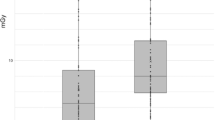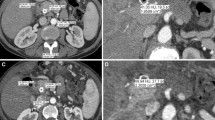Abstract
Purpose
To evaluate the reduction of out-of-field artifacts caused by body parts outside the field of view (FOV) at rapid kVp switching dual-energy CT (rsDECT).
Materials and methods
This retrospective study was approved by our institutional review board. Informed consent was not required. We viewed 246 consecutive rsDECT thoracoabdominal scans to identify those with body parts outside the maximal FOV of 50 cm. The maximal length, thickness, and subjective severity of the out-of-field artifacts were recorded for the 40, 65, and 140 keV virtual monochromatic and iodine and water density images. Artifact severity was rated on a 6-point scale from 0 = absent to 5 = obscures intraabdominal/intrathoracic anatomic detail. Artifact thickness and severity scores were compared by t-test and Wilcoxon tests, respectively.
Results
In 20 of 246 scans (8.1%), body parts extended past the maximum FOV of 50 cm. The mean BMI of these 20 patients was 40.2 kg/m2 (range, 26.83–61.69 kg/m2), and out-of-field artifacts occurred for all 20. The mean out-of-field artifact maximal length was 16.6 cm. The mean artifact thickness was significantly less for iodine density (0.6 mm) than for the 65 keV and water density images (8.4 and 13.5 mm, respectively, p < 0.001 each comparison). The mean artifact severity score was lower for iodine density (0.2) than for the 65 keV and water density images (2.5 and 2.6, respectively, p < 0.001 each).
Conclusion
Iodine density images reduce out-of-field image artifact at rsDECT and assists in the evaluation of peripheral tissues that extend beyond the maximal CT FOV.





Similar content being viewed by others
References
Bamberg F, Dierks A, Nikolaou K, et al. (2011) Metal artifact reduction by dual energy computed tomography using monoenergetic extrapolation. Eur Radiol 21:1424–1429
Kelly D, Hasegawa I, Borders R, Hatabu H, Boiselle P (2004) High-resolution CT using MDCT: comparison of degree of motion artifact between volumetric and axial methods. Am J Roentgenol 182:757–759
Brooks RA, Di Chiro G (1976) Beam hardening in X-ray reconstructive tomography. Phys Med Biol 21:390–398
Barrett JF, Keat N (2004) Artifacts in CT: recognition and avoidance. Radiographics 24:1679–1691. doi:10.1148/rg.246045065
Ng M, Fleming T, Robinson M, et al. (2014) Global, regional, and national prevalence of overweight and obesity in children and adults during 1980–2013: a systematic analysis for the Global Burden of Disease Study 2013. Lancet 384:766–781
Ohnesorge B, Flohr T, Schwarz K, Heiken JP, Bae KT (2000) Efficient correction for CT image artifacts caused by objects extending outside the scan field of view. Med Phys 27:39–46. doi:10.1118/1.598855
Maltz JS, Bose S, Shukla HP, Bani-Hashemi AR (2007) CT truncation artifact removal using water-equivalent thicknesses derived from truncated projection data. Conf Proc IEEE Eng Med Biol Soc 27:2907–2911. doi:10.1109/iembs.2007.4352937
Sourbelle K, Kachelriess M, Kalender WA (2005) Reconstruction from truncated projections in CT using adaptive detruncation. Eur Radiol 15:1008–1014. doi:10.1007/s00330-004-2621-9
Hsieh J, Chao E, Thibault J, et al. (2004) A novel reconstruction algorithm to extend the CT scan field-of-view. Med Phys 31:2385–2391. doi:10.1118/1.1776673
Marin D, Boll DT, Mileto A, Nelson RC (2014) State of the art: dual-energy CT of the abdomen. Radiology 271:327–342. doi:10.1148/radiol.14131480
Yu L, Leng S, McCollough CH (2012) Dual-energy CT-based monochromatic imaging. Am J Roentgenol 199:S9–S15. doi:10.2214/AJR.12.9121
Pessis E, Campagna R, Sverzut J-M, et al. (2013) Virtual monochromatic spectral imaging with fast kilovoltage switching: Reduction of metal artifacts at CT. Radiographics 33:573–583
Lee YH, Park KK, Song H-T, Kim S, Suh J-S (2012) Metal artefact reduction in gemstone spectral imaging dual-energy CT with and without metal artefact reduction software. Eur Radiol 22:1331–1340
Coursey CA, Nelson RC, Boll DT, et al. (2010) Dual-energy multidetector CT: how does it work, what can it tell us, and when can we use it in abdominopelvic imaging? Radiographics 30:1037–1055. doi:10.1148/rg.304095175
Ameli-Renani S, Rahman F, Nair A, et al. (2014) Dual-energy CT for imaging of pulmonary hypertension: challenges and opportunities. Radiographics 34:1769–1790. doi:10.1148/rg.347130085
Stiller W, Skornitzke S, Fritz F, et al. (2015) Correlation of quantitative dual-energy computed tomography iodine maps and abdominal computed tomography perfusion measurements: are single-acquisition dual-energy computed tomography iodine maps more than a reduced-dose surrogate of conventional computed tomography perfusion? Invest Radiol 50:703–708. doi:10.1097/rli.0000000000000176
Silva AC, Morse BG, Hara AK, et al. (2011) Dual-energy (spectral) CT: applications in abdominal imaging. Radiographics 31:1031–1046 (discussion 1047–1050). doi:10.1148/rg.314105159
Gupta S, Wagner-Bartak N, Jensen CT, et al. (2016) Dual-energy CT of pancreatic adenocarcinoma: reproducibility of primary tumor measurements and assessment of tumor conspicuity and margin sharpness. Abdom Radiol 41(7):1317–1324. doi:10.1007/s00261-016-0689-8
Winklhofer S, Lambert JW, Wang ZJ, et al. (2016) Reduction of peristalsis-related gastrointestinal streak artifacts with dual-energy CT: a patient and phantom study. Abdom Radiol 41(8):1456–1465. doi:10.1007/s00261-016-0702-2
Uppot RN, Sahani DV, Hahn PF, et al. (2006) Effect of obesity on image quality: fifteen-year longitudinal study for evaluation of dictated radiology reports. Radiology 240:435–439. doi:10.1148/radiol.2402051110
Reynolds A (2011) Obesity and medical imaging challenges. Radiol Technol 82:219–239
Carucci LR (2013) Imaging obese patients: problems and solutions. Abdom Imaging 38:630–646. doi:10.1007/s00261-012-9959-2
Karcaaltincaba M, Aktas A (2011) Dual-energy CT revisited with multidetector CT: review of principles and clinical applications. Diagn Interv Radiol 17:181–194. doi:10.4261/1305-3825.dir.3860-10.0
Guimaraes LS, Fletcher JG, Harmsen WS, et al. (2010) Appropriate patient selection at abdominal dual-energy CT using 80 kV: relationship between patient size, image noise, and image quality. Radiology 257:732–742. doi:10.1148/radiol.10092016
De Cecco CN, Buffa V, Fedeli S, et al. (2010) Dual energy CT (DECT) of the liver: conventional versus virtual unenhanced images. Eur Radiol 20:2870–2875. doi:10.1007/s00330-010-1874-8
Yeh BM, Shepherd JA, Wang ZJ, et al. (2009) Dual energy and low kVp CT in the abdomen. AJR Am J Roentgenol 193:47
Wu X, Langan DA, Xu D, et al. (2009) Monochromatic CT image representation via fast switching dual kVp. In: Proceedings of SPIE 7258, Medical Imaging: Physics of Medical Imaging, 725845, 13 Mar 2009
Winklhofer S, Lambert JW, Wang ZJ, et al. (2016) Reduction of peristalsis-related gastrointestinal streak artifacts with dual-energy CT: a patient and phantom study. Abdom Radiol 41:1456–1465. doi:10.1007/s00261-016-0702-2
Acknowledgement
The contents are solely the responsibility of the authors and do not necessarily represent the official views of the National Institutes of Health or the Swiss National Science Foundation.
Author information
Authors and Affiliations
Corresponding author
Ethics declarations
Funding
This publication was supported by grants from the National Institutes of Health (Grant No. 1R41DK104580) and the Swiss National Science Foundation (Grant No. P2SKP3_151973).
Conflict of interest
Brandan Dotson, Jack W. Lambert PhD, Yuxin Sun MS, and Michael A. Ohliger MD PhD declare that they have no conflict of interest. Zhen J. Wang MD has received grants from the NIH and is a shareholder in Nextrast, Inc. Sebastian Winklhofer MD has received research grants from the Swiss National Science Foundation, Benjamin M. Yeh MD has received research grants from the NIH and General Electric Healthcare, royalties from Oxford University Press, and is a shareholder in Nextrast, Inc.
Ethical approval
All procedures performed in studies involving human participants were in accordance with the ethical standards of the institutional review board and with the 1964 Helsinki declaration. This article does not contain any studies with animals performed by any of the authors.
Informed consent
Statement of informed consent was not applicable since the manuscript does not contain any patient data.
Rights and permissions
About this article
Cite this article
Dotson, B., Lambert, J.W., Wang, Z.J. et al. Benefit of iodine density images to reduce out-of-field image artifacts at rapid kVp switching dual-energy CT. Abdom Radiol 42, 735–741 (2017). https://doi.org/10.1007/s00261-016-0978-2
Published:
Issue Date:
DOI: https://doi.org/10.1007/s00261-016-0978-2




